1. ‘Tomato Red’ Bougainvillea (Bougainvillea ‘Tomato Red’)
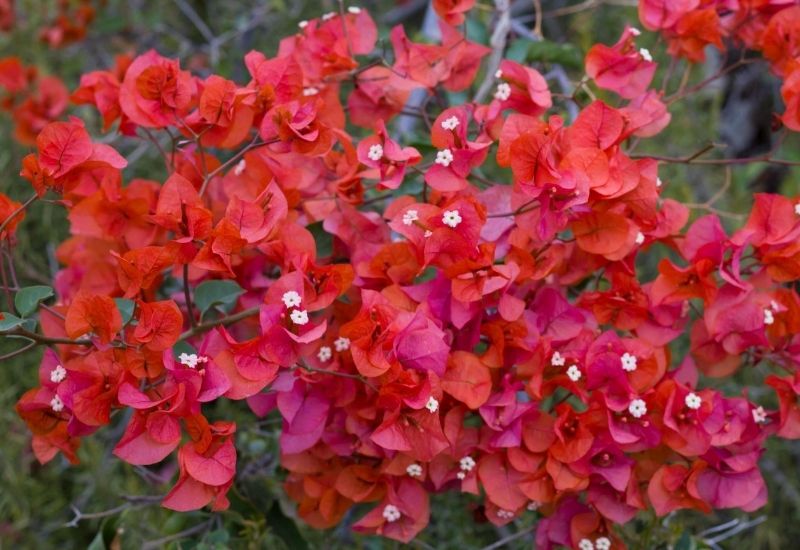
Bougainvillea is a spectacular evergreen sun-loving shrub, but a good red color is unusual in its varieties; ‘Tomato Red’ is arguably the best, with coral to terra cotta red bracts around the tiny white actual flowers.
They come in huge numbers and they last for weeks, while the dark green pinnate foliage is very lush and permanent on this vining bush. It is a fast grower, and a large plant, ideal only for warm climates like the Southern States though.
On fences and on walls, ‘Red Tomato’ bougainvillea will give you a thick and impenetrable hedge or cushion of lush leaves and an explosion of energy repeatedly throughout the whole year.
It is ideal for Mediterranean, South American and Hispanic garden designs, perfect for coastal gardens, but it courtyard and gravel gardens it can be quite beautiful too.
2. ‘Mister Lincoln’ Hybrid Tea Rose (Rosa ‘Mister Lincoln’)
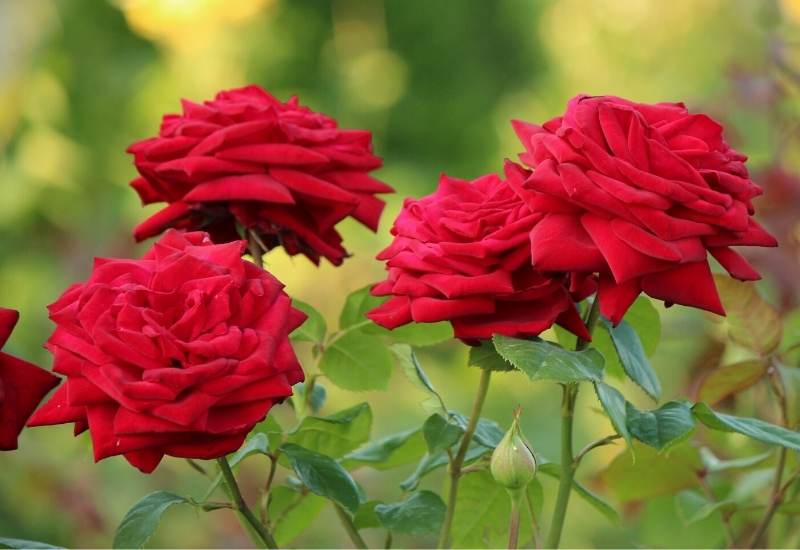
The amaranth red flowers of ‘Mister Lincoln’ hybrid tea rose are intense, velvety and very elegant.
With the iconic tea cup shape of this type of shrub roses, fully double with up to 40 petals each, they can reach 5 inches across (12 cm)!
It is a late bloomer that brings sumptuous intensity to your garden on long and straight stems that make it perfect for cutting. The leaves are dark green and leathery, giving you the perfect frame for the showy flowers. It also won the All American Rose Selection in 1965.
‘Mister Lincoln’ is a protagonist and an attention seeker; in beds and borders, it will suit any informal design, from cottage gardens to urban and suburban, even courtyard ones. And it looks like butterflies love it too!
3. ‘Midnight Marvel’ Rose Mallow (Hibiscus ‘Midnight Marvel’)
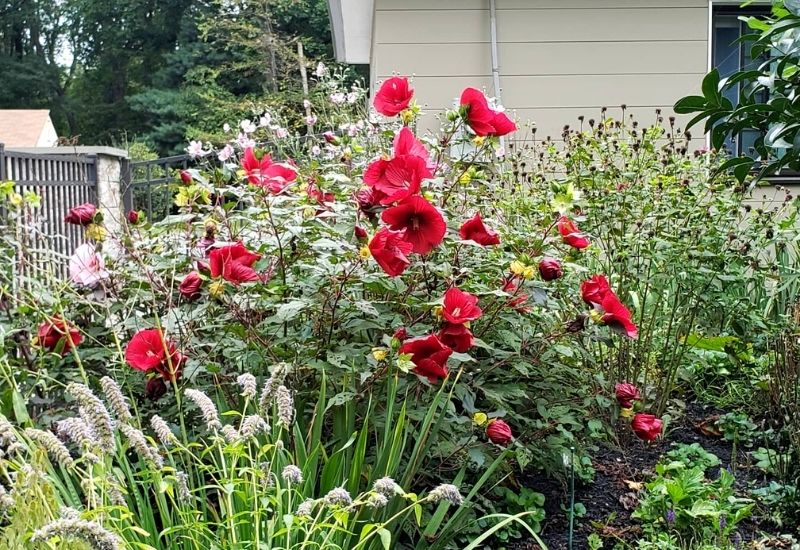
‘Midnight Marvel’ is an aptly named fairly small, compact rose mallow, or hardy hibiscus with a very striking look. The flowers are large, 9 inches across (22 cm), round, with overlapping petals in a spiral pattern and they are scarlet red with white dots (anthers) on the central red pistil with purple stigma.
But now imagine it against lush and shiny black foliage! Yes, because the leaves are such dark purple that they almost appear so! It also has a long blossom for two seasons and it tolerates cold regions too! Just perfect!
‘Midnight Marvel’ will bring depth and drama to any informal garden or even terrace, as is not big; of course, it is ideal for an exotic garden, but most other design, including urban ones and “outside rooms” would be fine.
4. ‘Les Jury’ Spring Blooming Camellia (Camellia X Williamsii ‘Les Jury’)
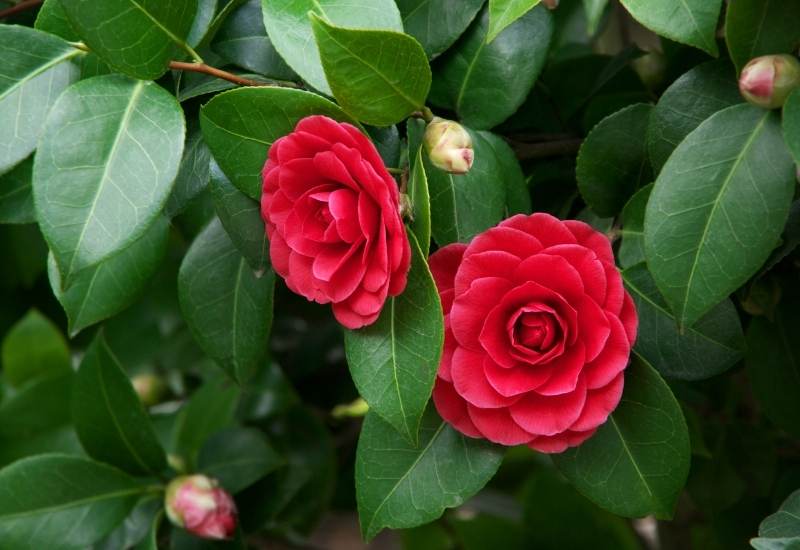
For a perfect crimson red camellia, spring blooming variety ‘Les Jury’ is just ideal. The blooms are double and with very regularly arranged petals with a middle fold and a slight tip. They form very decorative rosettes that are 4 inches in diameter (10 cm) and look like little sculptures! It is filled with elegant passion are set against very glossy, mid emerald green elliptical leaves when mature, though they are bronze when they start off. It is a winner of the prestigious Award of Garden Merit by the Royal Horticultural Society for its exceptional beauty.
‘Les Jury’ camellia would be perfect in a Japanese garden, it really has all that elegant balance, but in most other informal settings it would be a protagonist and a show stopper; it is suitable for containers, so you can have it in your terrace as well, or if your soil is alkaline.
5. ‘Knap Hill Scarlet’ Japanese Quince (Chaenomeles X Superba ‘Knap Hill Scarlet’)
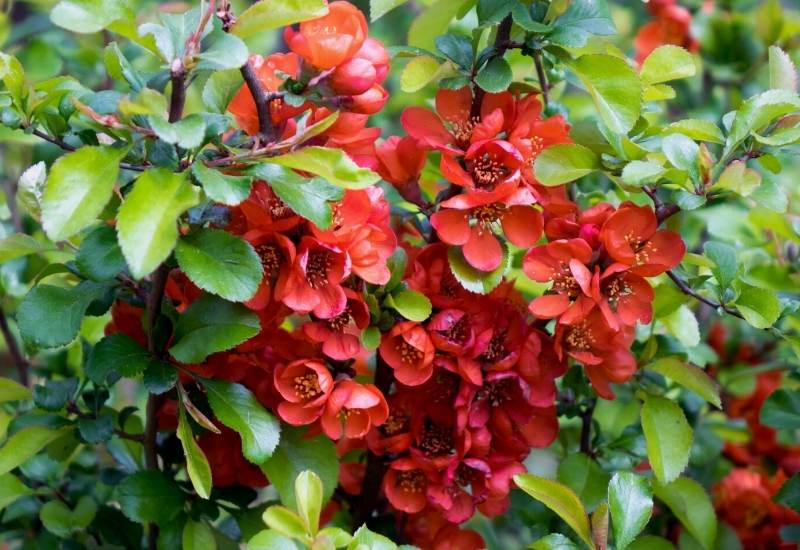
‘Knap Hill Scarlet’ is a hybrid Japanese quince that forms spreading deciduous shrubs with spiky branches and an overall very tangled look.
It has beautiful scarlet red round flowers that come in clusters over the branches when the leaves are still small, copper or light green, and each head is about 1.5 inches across (4.0 cm), with golden stamens in the center.
Once the blossom is spent, you will also get fruits that start off green and add some yellow when they ripen late in fall. You can eat the, but they are bitter, so ideal in sweets and jams.
‘Knap Hill Scarlet’ Japanese quince has a very natural, even mountainous look, so it is perfect in naturalistic gardens, including Japanese ones of course. Great on banks and slopes but also as wall side shrub or borders and wind screens.
6. ‘Robleza’ Rhododendron (Rhododendron ‘Encore Autumn Bonfire’)
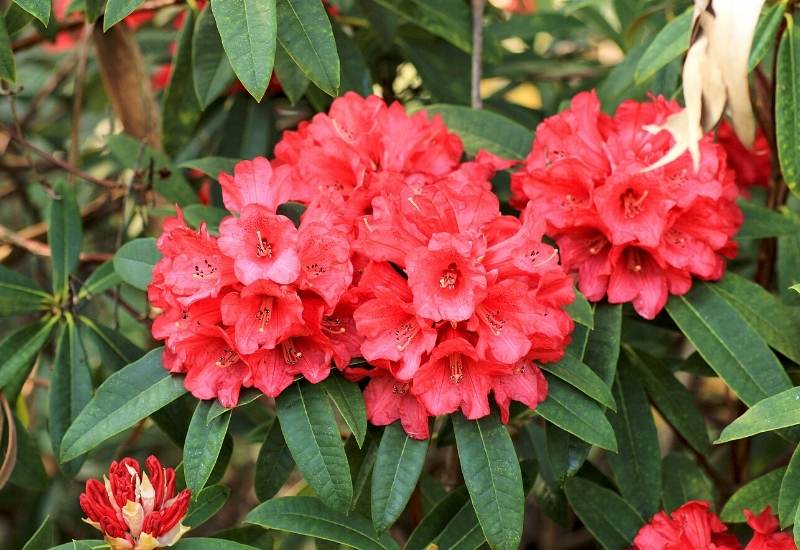
‘Robleza’ only forms a small shrub, but a very vibrant one! Also known as ‘Encore Autumn Bonfire’, it is a re-blooming bush with very abundant blossoms, especially in spring. The flowers are semi double, fiery red, intense and fairly large, 2.5 inches across (5.0 cm). They will stand out perfectly against the tiny, elliptical light green leaves, which will stay on in winter as well. This plant has a round habit and it is a tough little beauty: it tolerates both heat and cold.
‘Robleza’ is a perfect accent plant with generous red blooms for informal gardens and terraces; from cottage gardens to urban designs, your hedge, border or containers fire up for months with this quality cultivar.
7. ‘Ruby Mound’ Chrysanthemum (Chrysanthemum ‘Ruby Mound’)
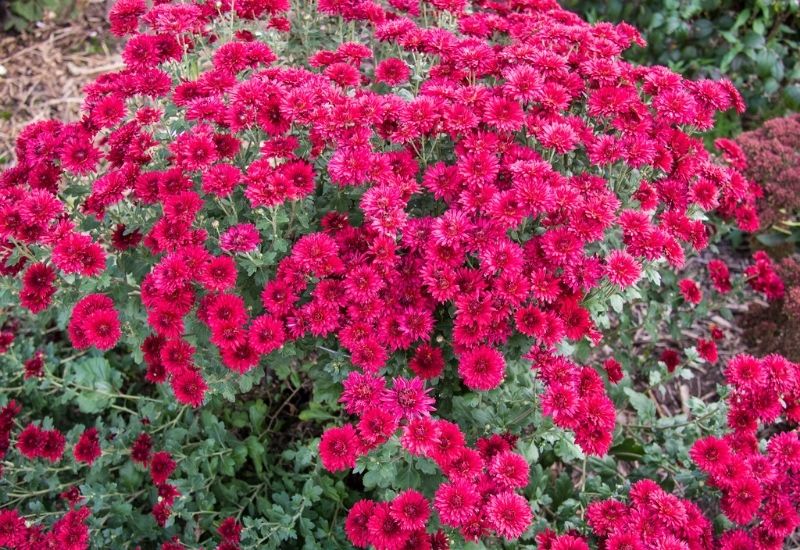
‘Ruby Mound’ is a chrysanthemum, so technically a perennial, but it forms small shrubs, so we wanted to show it to you!
The large double flowers are about 3 inches across (7.5 cm!) round and packed with petals, like flattened ruby red pompoms. They come abundantly in October and November, depending on sunlight hours where you live. The bushes have a round habit and the foliage sets off the flower heads that grow on dark purple stems with its intricate and thick green texture. It is a winner of the Award of Garden Merit by the Royal Horticultural Society.
‘Ruby Mound” is a plant for a big blush late in the season in informal beds, borders or containers and good for cut flowers. It needs a sheltered location though, as it does not like string winds.
8. ‘Sonic Bloom Red’ Weigela (Weigela ‘Sonic Bloom Red’)
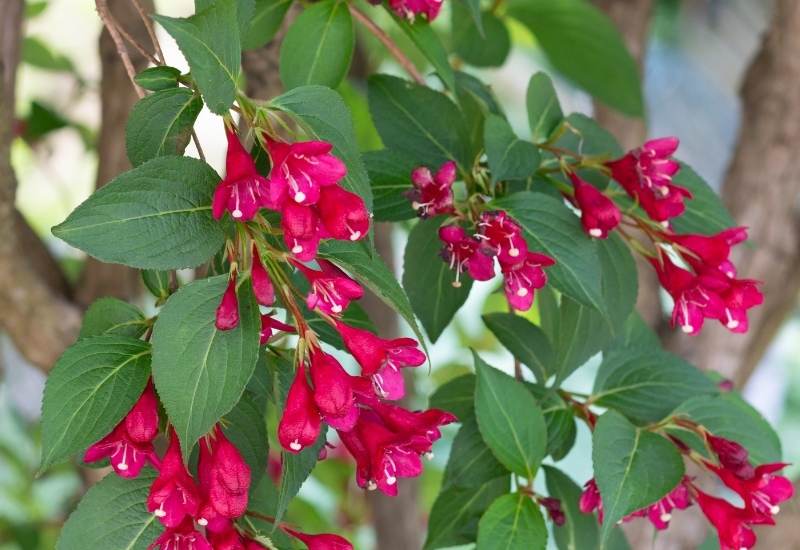
‘Sonic Bloom Red’ weigela will give you raspberry red blooms from spring to frost!
These are very abundant, and made up of many long and trumpet shaped flowers that fill the tips of the branches repeatedly throughout the year, even without deadheading. The elliptical and pointed green foliage is the perfect setting for these displays, which also attract butterflies, bees and hummingbirds.
It has a cheerful and even playful look and a round habit, with a herbaceous quality that makes it ideal for fresh but vibrant gardens.
‘Sonic Bloom Red’ is perfect for herbaceous borders in informal and natural looking gardens in the Sun. Low maintenance but high performance; it’s a real safe bet! Ideal for most temperate regions in the USA and beyond.
9. ‘Little John’ Bottlebrush (Calllistemon Viminalis ‘Little John’)
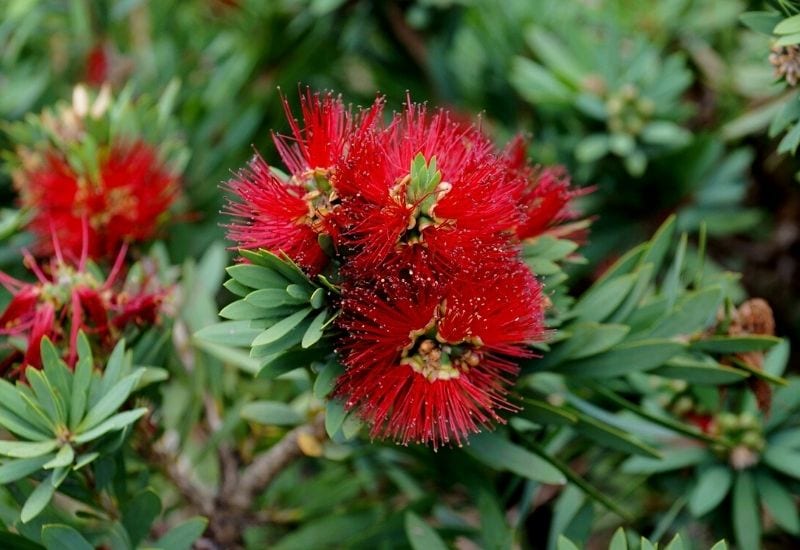
There are many bottlebrush varieties with bright red blooms, but we picked ‘Little John’ thinking about small sized gardens. This dwarf variety has short but still lovely “bottle brushes”; the blooms of this genus are very original indeed, made up of many thin filaments arranged in a cylindrical shape.
Our diminutive star has them in a blood red shade with tiny yellow tips. It is also special because the evergreen foliage is on the blue range and it is thick and made up of many elliptical and pointed leaves that form rosettes at the end of the branches.
You may prefer other red varieties of bottlebrush, like ‘Captain Cook’ or crimson bottlebrush, but the plus side with ‘Little John’ is that you can have this exotic looking plant even in color regions, as long as you grow it in containers and you shelter it in winter.
10. Nodding Pincushion (Leucospermum Cordifolium)
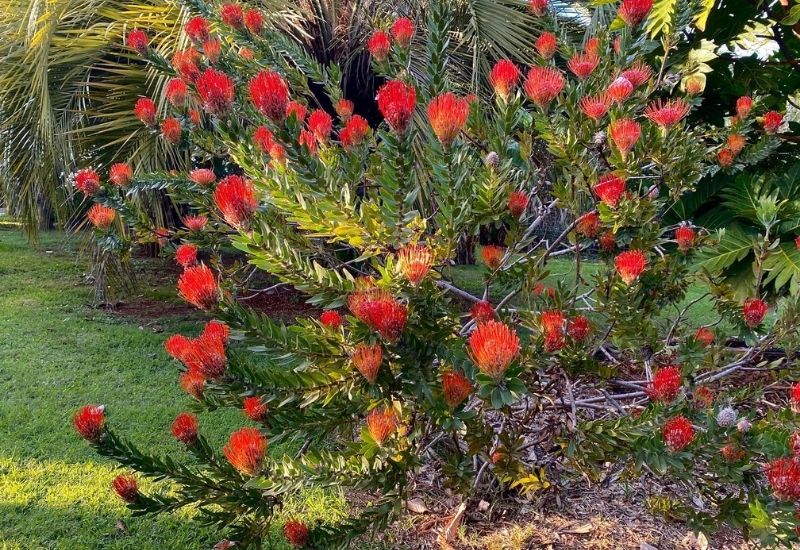
The large flower heads of nodding pincushion reach 5 inches (12 cm) and they can be crimson red, though there are varieties of other colors (pink and orange).
They are also unusual, as the name suggests, with many filament like petals that form a globular fluff of vibrancy. They look very exotic and they come repeatedly on the long upright branches with evergreen foliage.
The leaves are leathery, large and green, arranged in spirals around the stalks. The overall habit is round, forming beautiful bushes with a tropical look.
Having said this, nodding pincushion can adapt to most informal beds and borders, not just exotic ones, as it is showy and delicate enough.
You can even grow it in containers, especially if you want a very glaring terrace or if you need to overwinter it in colder regions.
11. Coral Plant (Barberisopsis Corallina)
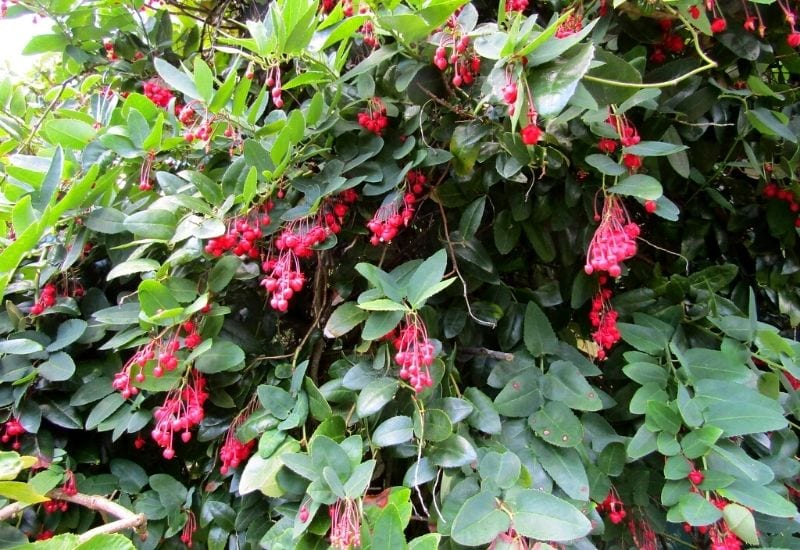
Coral plant is a climbing shrub with lots of red to offer…. The flowers are ruby red and original… They look like the outer wings of beetles with a central cluster of red pistils, forming what looks like a raspberry inside the hanging and nodding bloom!
They describe them like “drop earrings”. These clusters then turn into scarlet berries that keep you company and maintain the color theme for months afterwards.
The evergreen, leathery elliptical foliage points up from the branches, like wings, while blooms and berries hang beneath. A lovely effect, both contrasting and balanced.
Coral plant is ideal as a wall side shrub, but otherwise, grow on pergolas, trellises and in borders with any informal design.
12. ‘Tom West’ Hardy Fuchsia (Fuchsia ‘Tom West’)
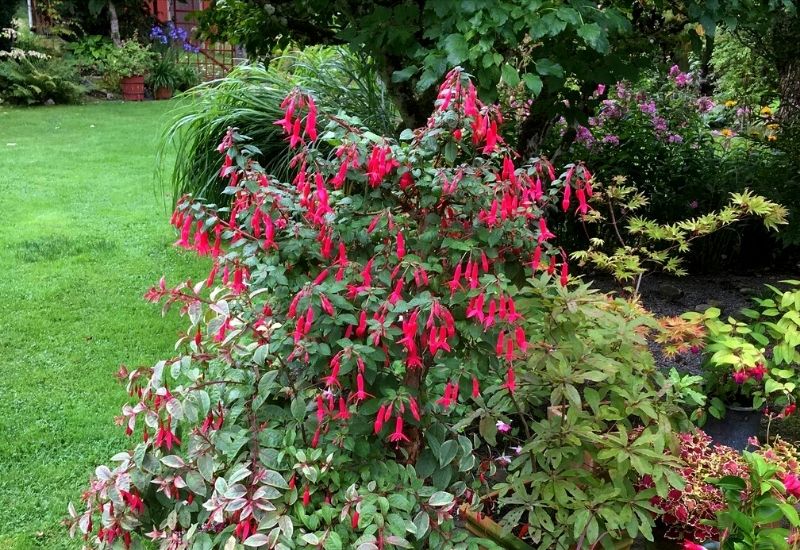
We couldn’t miss out a shrub that gives the name to a shade of red: fuchsia…
Our chosen cultivar is one of the “reddest” varieties; the outer petals (tepals) are crimson to chili red, while the internal crown of the nodding bloom is actually fuchsia.
It blossoms for months on end, and the foliage is just fantastic! The elliptical deciduous leaves are light green with cream edges and, again a blush of fuchsia, all growing on tender branches that become purple as they stretch out.
This explosion of colors must have been a winning factor when the Royal Horticultural Society gave it the Award of Garden Merit.
‘Tom West’ fuchsia is great in hanging baskets or containers on patios and terraces, but also in beds and borders in informal settings, but especially gravel and rock gardens.